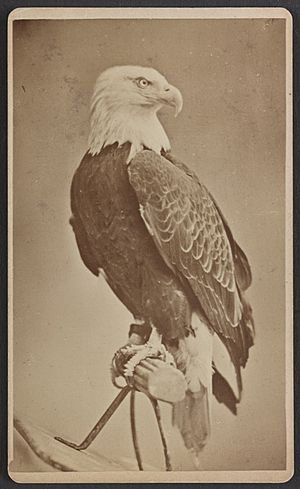8th Wisconsin Infantry Regiment facts for kids
Quick facts for kids 8th Wisconsin Infantry Regiment |
|
|---|---|

|
|
| Active | September 13, 1861 – September 5, 1865 |
| Country | United States |
| Allegiance | Union |
| Branch | Infantry |
| Size | Regiment |
| Engagements | |
| Commanders | |
| Colonel | Robert C. Murphy |
| Colonel | George W. Robbins |
| Colonel | John W. Jefferson |
| Colonel | William B. Britton |
The 8th Wisconsin Infantry Regiment was a group of volunteer soldiers. They fought for the Union Army during the American Civil War. This regiment was special because its mascot was Old Abe, a real bald eagle. Old Abe even went with the soldiers into battles!
Contents
Service and Time in the War
The 8th Wisconsin Regiment was formed in Madison, Wisconsin. Its soldiers officially joined the United States Army on September 13, 1861. They were ready to serve their country.
After four years of fighting, the regiment finished its service. The soldiers were officially released from duty on September 5, 1865. This happened in Demopolis, Alabama.
Important Battles and Events
The 8th Wisconsin Infantry and their eagle mascot, Old Abe, took part in many important battles. Here are some of the key moments they experienced:
- New Madrid and Island #10 (March & April 1862): Union General John Pope captured Point Pleasant, Missouri. This made the Confederate soldiers leave New Madrid. They left behind a lot of supplies.
- Iuka, Mississippi (September 16–18, 1862): This was a tough battle where the Union Army tried to stop Confederate forces.
- Corinth, Mississippi (October 3–4, 1862): The regiment fought hard in this major battle. It was a victory for the Union.
- Vicksburg, Mississippi (May-July 1863): The 8th Wisconsin helped surround and capture the city of Vicksburg. This was a very important victory for the Union.
- Red River Campaign (March-May 1864): This was a series of battles in Louisiana. The regiment faced many challenges during this campaign.
- Nashville, Tennessee (December 15–16, 1864): This was one of the last big battles of the war. The 8th Wisconsin helped the Union win a major victory.
- The Mobile Campaign (March-April 1865): Near the end of the war, the regiment helped capture Mobile, Alabama.
Soldiers and Losses
The 8th Wisconsin Regiment started with 870 soldiers. Later, 333 more men joined, making a total of 1,203 soldiers who served.
Sadly, war always brings losses. The regiment lost 2 officers and 53 enlisted men who were killed in battle or died from their wounds. Another 2 officers and 219 enlisted men died from diseases. In total, 280 soldiers from the 8th Wisconsin Regiment lost their lives.
Leaders of the Regiment
The regiment had several important leaders, called Colonels:
- Colonel Robert C. Murphy (July 11, 1861 – January 10, 1863): He was the first Colonel. He was later removed from his position because he did not properly protect supplies twice.
- Colonel George W. Robbins (December 20, 1862 – September 1, 1863): He was wounded during the Second Battle of Corinth.
- Colonel John W. Jefferson (September 1, 1863 – October 11, 1864): He was a grandson of U.S. President Thomas Jefferson. He was wounded twice during his service.
- Colonel William B. Britton (October 11, 1864 – September 5, 1865): He was wounded at the Battle of Nashville. After the war, he served in the Wisconsin State Assembly, which is like a state government body.
Interesting People from the Regiment
Many brave and interesting people served in the 8th Wisconsin Regiment:
- Thomas J. Bowles: He was a private soldier. After the war, he also served in the Wisconsin State Assembly.
- Augustus G. Weissert: He rose to the rank of sergeant major. After the war, he became a very important leader of the Grand Army of the Republic. This was a large group for Civil War veterans.
- William P. Lyon: He started as a captain in the 8th Wisconsin. He later became a colonel of another regiment. After the war, he became a judge and even the Chief Justice of the Wisconsin Supreme Court.
- George Washington Glover Jr.: He was the only son of Mary Baker Eddy, a famous religious leader. He was a private soldier and was wounded at Corinth.
- Ezra T. Sprague: He was an adjutant, which is an officer who helps with administration. He later became a colonel of another regiment and a judge.
See also
- List of Wisconsin Civil War units
- Wisconsin in the American Civil War
Images for kids



